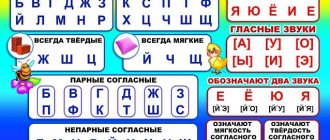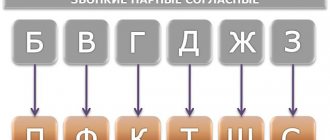How different are these consonant sounds?
There's a lot of trouble with letters, that's the kind of people they are.
Sounds change without asking and pretend to be different.
How much trouble these letters and sounds cause for children! Learn the letters, and then remember when and what sound they represent! And there are oh-oh-oh so many sounds. How can you remember all the voiced and voiceless consonants ?
Everything turns out to be very simple if you set up your child correctly.
I have already written about hard and soft consonant sounds. But consonants are not only hard and soft, but also voiced and unvoiced. And they cause so much trouble for children in the form of mistakes! How to teach a child to correctly identify voiced and voiceless consonants ?
Simply memorizing voiced and voiceless consonants is a losing proposition. Even if the child remembers, it will be very difficult for him to apply this knowledge. But if a child understands how voiced and unvoiced sounds are made, learns to hear them and identify them by their signs, then it will be easy for him to remember.
Let's first figure out the voiced and voiceless consonant sounds .
In the Russian language, consonant sounds are divided into voiced and voiceless, depending on the participation of the voice in the pronunciation of the sound. How to determine this? Say a single consonant sound and place your hand to your throat. If the vocal cords vibrate, it is a ringing sound. If not, then you are deaf. Check with your child and pronounce the sounds B - P, M or X. Did you notice?
Voicedness or deafness can be defined differently. Cover your ears with your palms and say a consonant sound. Did you hear a voice or noise? If a voice is heard, then the sound is ringing, if the noise is dull.
And this way you can easily and simply determine the voicedness or dullness of a consonant . At first, this method is very good. But if the child continues to determine the voicedness or deafness of a consonant in this way, then this will take a lot of time. The child will not have time to complete work in class. Therefore, it is necessary for the child to remember voiced and voiceless consonants.
And here we need to remember that the brain can perceive information in different ways - through hearing, vision or sensations. This means that in order for a child to remember information, it is necessary to influence all the child’s systems.
By determining the voicedness and deafness of consonants by ear, we have already included hearing in the work. By putting our hand to our throat, we connected the sensations. Now we need to connect our vision. To do this, you need to make a sign or drawing, where you denote the voiced and voiceless consonants with some symbols.
Voiced and voiceless consonants are paired and unpaired. This means that when creating such a diagram or tablet, you need to place paired consonants side by side. You can use any symbols that remind the child that the sound is voiced or unvoiced. So in this scheme, voiced consonants are indicated by a bell, and voiceless consonants are indicated by headphones.
Draw a similar sign with your child. Let him independently place the letters near the desired symbol, and you just control and guide the child’s actions. Remember that a person will only remember well what he did on his own.
Play with the placement of letters on floors or houses with the desired symbol several times and the child will perfectly remember the voiced and voiceless consonants. Hang this sign in a visible place and periodically return to it, ask the child to tell, show, name some sounds.
So, by playing, repeating already familiar properties of sounds and letters, you will help your child learn the basics of the Russian language without difficulty, remember voiced and voiceless consonants .
Have questions? Write in the comments to get an answer.
In the meantime, get some positivity and watch a wonderful cartoon. Let's learn from this cheerful monkey to find the good in everything.
Phonetics - the kingdom of sounds
Today, almost all children know letters and the alphabet already in early childhood. However, it is recommended to learn letters without naming the letters as they sound in the alphabet. Letters must be taught with sounds. When talking about the letter “B”, it is necessary to call it [b], and not “be”. This is necessary so that it will be easier for the child to combine letters into syllables and words.
However, the world of sounds does not end there. And when the baby grows up, he will have to master such concepts as vowel sounds, hard, soft, paired, voiceless and voiced consonants. I invite you to talk today about such different sounds. We will talk about this in a fairy-tale form, in a form closest to children's perception. I invite you to a phonetic fairy tale . This is an expanded version of the tale about sounds presented in the book "Fairytale Kingdom".
So, friendly letters live in the hospitable city of Bukvograd. And sounds created a large Kingdom called Phonetics.
In the kingdom of sounds of the Russian language, Phonetics lived together - vowels and consonants . Each sound had its own house. For vowels, the houses were painted red, and for consonants, blue. But the roofs of all the houses were white and changed on their own when the sounds visited each other.
42 inhabitants in the kingdom 6 vowel sounds [a], [e], [o], [u], [i], [s] and 36 consonants. They lived amicably and often visited each other. And every time they visited each other, magic happened: as soon as they held hands, new sounds were created for new words.
Vowel sounds loved to be sung. Therefore, there was always music playing in their houses. But with consonant sounds it was not possible to sing at all. But they were very pliable and always “agreed” with the vowels in everything. At the same time, they could become hard or soft . For example, the sound [p]. The word “saw” sounds soft, but the word “dust” sounds hard. And all because the sound [i] softened the [p], and the sound [s], on the contrary, made it harder.
This is how consonant sounds, joining hands with vowels, become soft or hard at their request.
However, there were also “naughty” sounds in the kingdom. And although they lived in blue houses and were called consonants, they did not want to change in any way. And this happened on the day when, sitting idly on benches, they argued about who was more important: vowels or consonants. And the sounds [zh] , [w] and [ts] decided to become independent and not obey anyone, especially vowel sounds. They proclaimed themselves to be hard sounds that would never, under any circumstances, become soft! And to prove their firm decision, they painted the white roofs of their houses dark blue.
But the compliant and non-conflicting sounds [sch] , [th] and [ch] were very upset and afraid that the balance of the ratio of sounds in the kingdom would be upset and decided to remain soft forever. And so that all the residents of Phonetics knew about this, they painted the roofs of their houses green.
However, soon 2 more inhabitants appeared in the kingdom of Phonetics - soft and hard signs. But they did not violate the unity of the sound world. The soft sign helped the consonants become soft, and the hard sign helped the consonants become hard. They built themselves white houses and everyone lived peacefully and amicably.
But the inhabitants of the Kingdom of Phonetics were famous not only for their hard and soft characters. Many of them had and still have their own special preferences. Some sounds loved the sound of falling leaves, while others loved the sound of rain. They even built separate quarters for themselves so that in one the bell always rings loudly, and in the other, as if under a dome, it is dull and noisy... This is how voiced and voiceless consonants . And a river flows between the blocks.
So in the quarter with the bell the sounds [r], [l], [m], [n], [y], [b], [g], [v], [d], [z], [z] settled . And in a quiet quarter - [p], [f], [t], [w], [s], [k], [x], [ts], [h], [sch]. And some letters became so friendly that they connected their houses with bridges. So there is a bridge between the sounds p-b, f-v, t-d, sh-zh, s-z and k-g. These are paired consonants .
This is how the amazing Kingdom of Phonetics lives. The sounds visit each other, change, adjust, make noise, shout, sing... They have fun. And in this fun words are born, from them the sentences that make up our speech. By the way, speech happens... However, we’ll talk about this another time.
These are the complex relationships between sounds.





